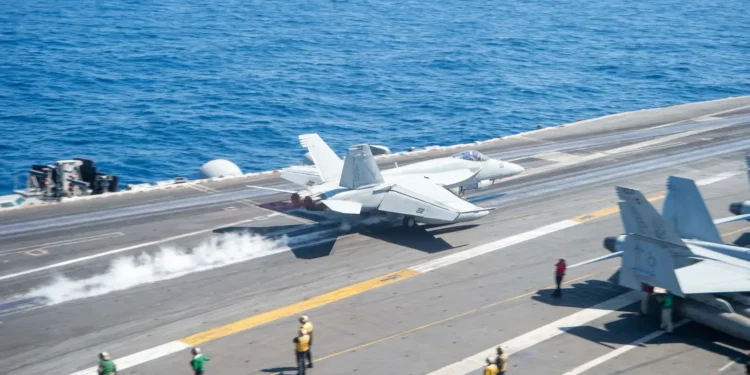A fighter jet and a helicopter based off the aircraft carrier USS Nimitz both crashed into the South China Sea within 30 minutes of each other, the Navy’s Pacific Fleet said.
The three crew members of the MH-60R Sea Hawk helicopter were rescued on Sunday afternoon, and the two aviators in the F/A-18F Super Hornet fighter jet ejected and were recovered safely, and all five “are safe and in stable condition,” the fleet said in a statement.
The causes of the two crashes were under investigation, the statement said.
President Donald Trump, speaking to reporters aboard Air Force One en route to Tokyo on Monday, said the incidents could have been caused by “bad fuel.” He ruled out foul play and said there was “nothing to hide.”
The USS Nimitz is returning to its home port in Naval Base Kitsap in Washington state after having been deployed to the Middle East for most of the summer as part of the U.S. response to attacks by Yemen’s Houthi rebels on commercial shipping. The carrier is on its home port in Naval Base Kitsap in Washington state after having been deployed to the Middle East for most of the summer as part of the U.S. response to attacks by Yemen’s Houthi rebels on commercial shipping. The carrier is on its final deployment before decommissioning.
Another aircraft carrier, the USS Harry S. Truman, suffered a series of mishaps in recent months while deployed to the Middle East.
In December, the guided-missile cruiser USS Gettysburg mistakenly shot down an F/A-18 jet from the Truman.
Then, in April, another F/A-18 fighter jet slipped off the Truman’s hangar deck and fell into the Red Sea.
And in May, an F/A fighter jet landing on the carrier in the Red Sea went overboard after apparently failing to catch the steel cables used to stop landing planes and forcing its two pilots to eject.
No sailors were killed in any of those mishaps. The results of investigations into those incidents have yet to be released.
The 30-minute interval between the MH-60R Sea Hawk helicopter crash and F/A-18F Super Hornet crash suggests either common mechanical failure affecting multiple aircraft systems simultaneously or cascading emergency where the first incident triggered conditions contributing to the second.
The successful rescue of all five crew members demonstrates effective search and recovery operations in the South China Sea, where carrier strike groups maintain constant ready alert postures with rescue helicopters and support vessels positioned for immediate response to aviation emergencies.
President Trump’s “bad fuel” speculation raises questions about fuel quality control aboard the USS Nimitz, as contaminated aviation fuel could cause simultaneous engine failures across different aircraft types drawing from common shipboard fuel supplies.
The USS Nimitz’s return to Naval Base Kitsap after Middle East deployment places the incidents during transit through contested South China Sea waters, where carrier operations maintain high operational tempo despite crews’ fatigue from extended deployment stress.
The final deployment before decommissioning context suggests the USS Nimitz, commissioned in 1975, operates aging aircraft and support systems nearing end of service life where maintenance challenges increase accident risks compared to newer carriers with modern equipment.
The USS Harry S. Truman’s serial mishaps including the USS Gettysburg friendly fire shootdown, hangar deck F/A-18 slip into Red Sea, and failed arrested landing demonstrate systemic Navy aviation safety crisis extending beyond single carrier incidents.
The December friendly fire incident where USS Gettysburg shot down Truman’s F/A-18 represents catastrophic identification failure where Aegis combat systems misidentified friendly aircraft as threats, raising questions about procedures preventing fratricide in complex battlespace environments.
The April hangar deck incident where F/A-18 slipped overboard suggests deck securing failures or human error during aircraft repositioning operations, routine but hazardous procedures where mistakes send multimillion-dollar jets into the ocean.
The May arrested landing failure forcing pilot ejection after missing arresting cables illustrates dangers of carrier aviation where pilots must catch four steel cables stretched across flight decks at precise speeds, with misses potentially sending aircraft over bow into water.
The absence of sailor deaths across five separate incidents in seven months represents fortunate outcomes but masks underlying systemic problems that accident-free results obscure, as each mishap destroyed expensive aircraft and could have easily killed crew members.
The unreleased investigation results for USS Harry S. Truman incidents suggest either ongoing analysis complexity requiring extensive time or Navy reluctance to publicize findings revealing embarrassing procedural failures, equipment deficiencies, or training inadequacies.
Naval Base Kitsap’s role as USS Nimitz home port makes the incidents particularly relevant to Washington state communities where thousands of sailors’ families await the carrier’s return, with crash news generating anxiety about loved ones’ safety despite confirmation all crew survived.
The South China Sea location carries geopolitical implications as the Navy operates in waters China claims as territorial seas, with accidents potentially emboldening Chinese criticism of U.S. military presence while demonstrating operational risks of maintaining carrier presence in contested regions.
The MH-60R Sea Hawk helicopter variant serves anti-submarine warfare and anti-surface roles crucial to carrier strike group defense, with its loss temporarily degrading USS Nimitz’s ability to detect submarines or surface threats until replacement aircraft arrives.
The F/A-18F Super Hornet two-seat variant serves multiple roles including strike fighter, electronic warfare, and aerial refueling missions, with its loss reducing carrier air wing combat capability during final deployment as the Nimitz heads home for decommissioning.







